Tipton County and West Tennessee
Tipton County was originally settled primarily by Middle and East Tennesseans, although most of the land was owned by citizens of North Carolina who had been granted the land by the State of North Carolina. Few of these North Carolinian land owners ever actually became settlers in Tipton County. The first settlement was near Covington around 1821 or 1822 by Jacob Tipton, F. Marshall and others. In 1823, settlements were established on the Mississippi River, below the second Chickasaw Bluff and on Indian Creek (south of Covington, near present day Brighton). Between 1830 and 1835 quite a number of settlers came in from North and South Carolina, Alabama, Virginia Kentucky and East and Middle Tennessee, attracted by the abundance of rich farm land. Among these were the Glasses, Wilsons, McCains, McIntoshes, Adkins, Bairds, Thompsons, Bowers, Dixons, Sullivans, Brooks, Wootens, Munfords, and Tuckers.
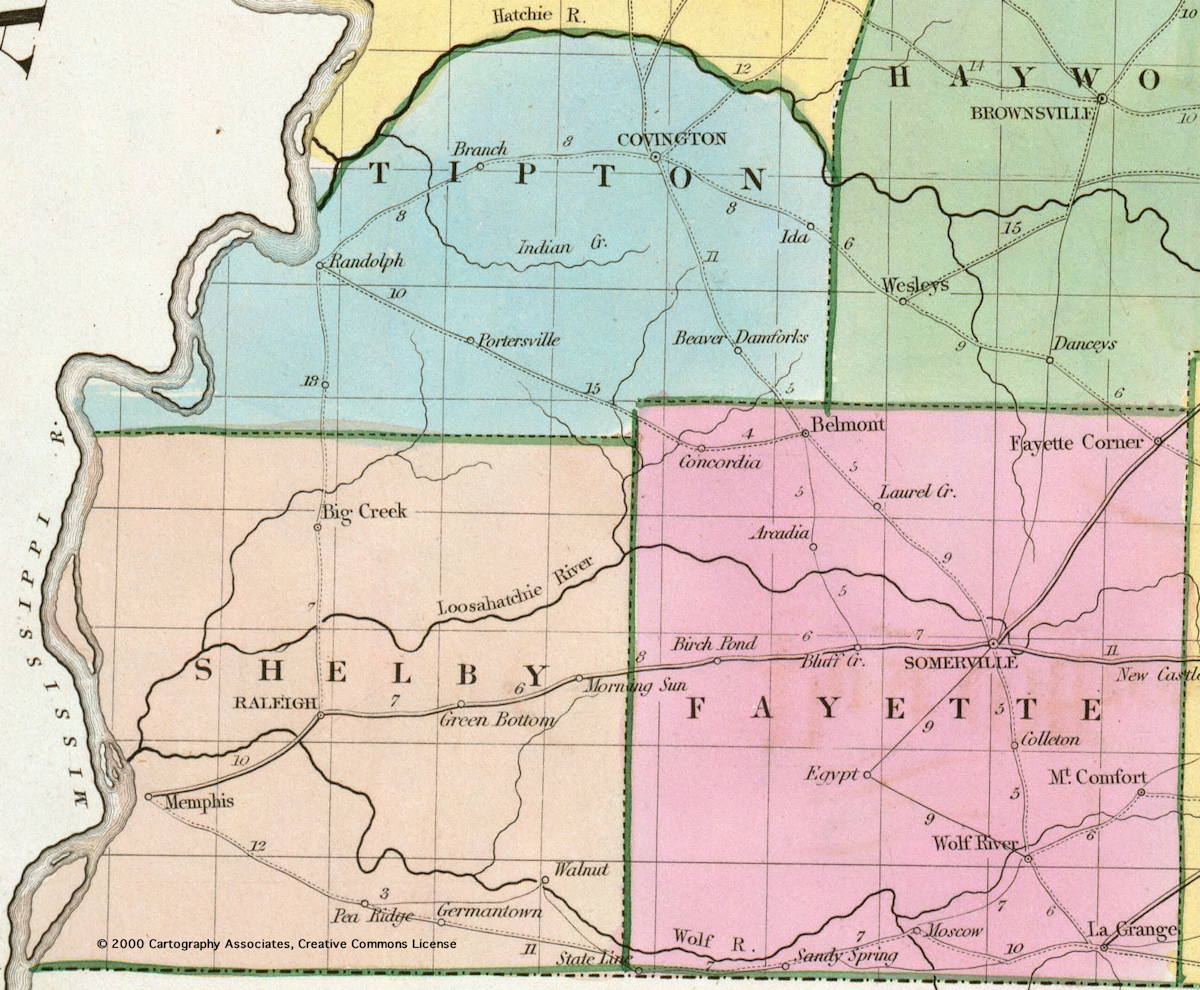
Southwest Tennessee, 1839*
Tipton County was formed out of Shelby County on October 29, 1823, and named for Captain Jacob Tipton, who was killed at St. Clair's defeat (Battle of Wabash River, November 4, 1791, in the Northwest Territory between the United States and the Western Confederacy of American Indians, as part of the Northwest Indian War). As originally formed, about two-thirds of the county was on the North side of the Big Hatchie River. In 1836, the area north of the Big Hatchie River was taken away to form Lauderdale County.
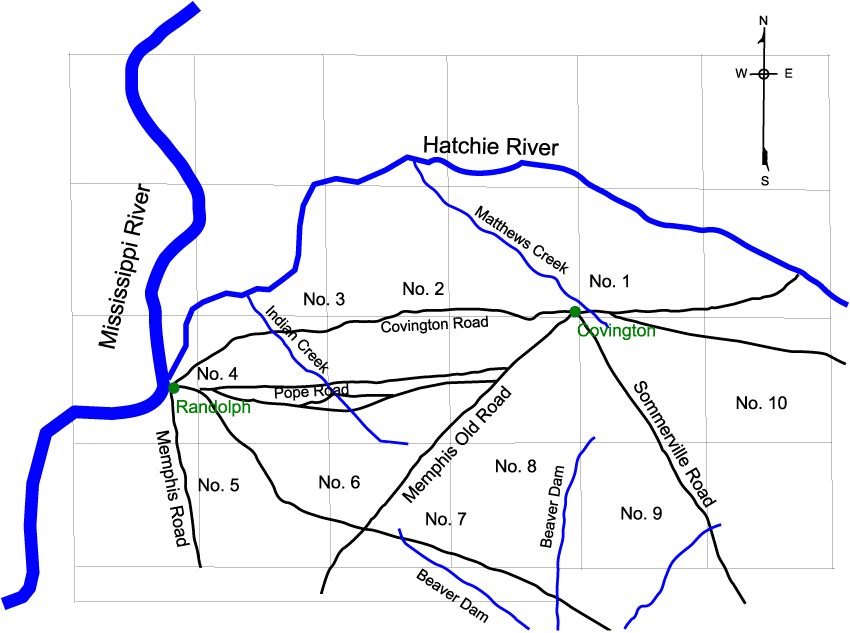
Tipton County Civil Districts, 1836. Redrawn from copy of original hand drawn map.
Atoka (Salem and Portersville)
The area that is now Atoka was first an Indian village. The first white inhabitants of this community were immigrants, having come from Ireland via Chester, South Carolina. The Porterville Post office opened on 28 December 1831 in the home of Robert W. Hart and the settlement was called Hartsfield at that time. Porterville was established in 1832 by James Hodges in the area that is now the Salem Community and the Post Office was moved from Hartsfield to Porterville. Porterville had a cotton gin, operated by W. M. Simonton, a tannery, owned by William Simpson and a saw mill and brick kiln were nearby. Porterville had a school, the Robinson School, and this was apparently one of the inducements that attracted settlers to the area.
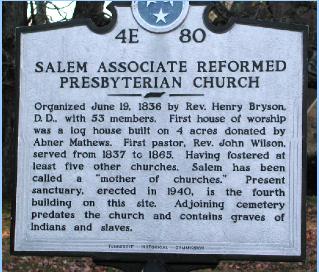
The Salem Associate Reformed Presbyterian Church was one of the earliest churches in the area. In 1835, a meeting was held at the home of Abner Mathews to discuss ways to secure a minister for preaching and the organization of a church. The following summer a log cabin was built on land donated by Mathews and on 19 June 1836 the congregation of Salem was organized by Rev. Henry Bryson. Fifty-three members were enrolled. On April 19, 1837, Rev. John Wilson was installed as pastor of the newly organized Salem ARP Church. By 1860, the congregation had grown to 325 members and 125 families. In 1855, a number of families who were members of the Salem ARP moved to Drew County, Arkansas and there they organized an ARP congregation at Monticello. (Among the families that moved to Arkansas was Hugh Wilson who had married Jane McQuiston. Their daughter, Sallie Wilson would marry Austin Quay Boyd in Arkansas in 1871, a descendant of Alexander and Martha Boyd.)
Next to the church is the Salem ARP Cemetery where many of the Boyd's and their relatives are buried.
On 10 June 1861 there was a vote in Tennessee to dissolve the union between Tennessee and the United States. Tipton County cast 943 votes for secession and 16 votes against. All 16 “no” votes were cast in Porterville.
In 1872, the Newport News and Mississippi Valley Railroad was built, passing though nearby Atoka (3 miles to the West) and commerce moved from Porterville to Atoka. The Porterville Post Office closed on 8 October 1873 and that same day, the Atoka Post Office opened. Today there is not a single store or building left in Porterville. The town of Atoka was named for Captain Atoka Oshlatubee, Chief of the Pushmataha district. He was born in 1792 and died during the Civil War. His name was derived from Choctaw "hitoka" meaning ball ground. Atoka was first incorporated prior to 1876, but the charter lapsed. The Atoka charter was renewed on 24 June 1911.
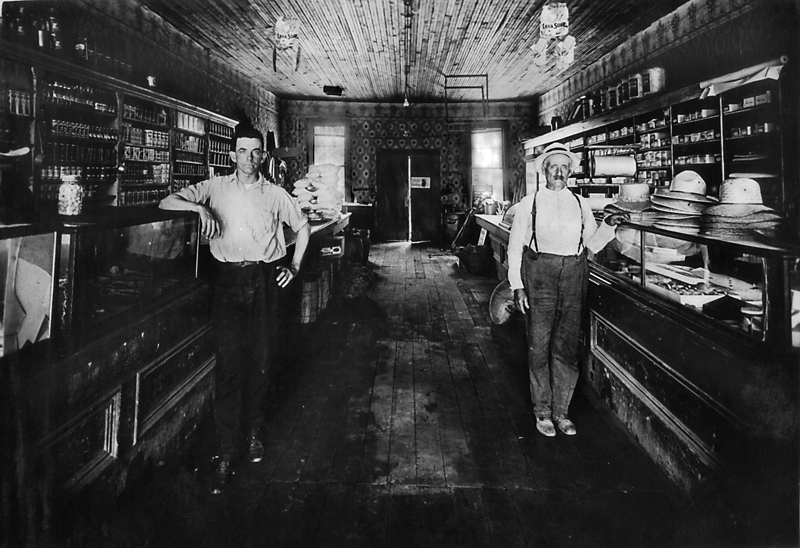
Hugh Boyd (left) in his store in Atoka with Thom Forbess in the early 1920's
Munford
Munford, about 4 miles west of Porterville, was originally Mount Zion. In the early 1850s the Mt. Zion Methodist Episcopal Church moved to the current site of the Munford Presbyterian Church. The community that grew up around the Methodist church was also known as Mt. Zion. In 1853 the Tipton Lodge No. 226 of the Free and Accepted Masons was founded in Munford.
The first post office in Mt. Zion was opened on 17 June 1856, but was closed on 3 August 1874. In 1886, Mt. Zion applied to the US Post Office Department to have the Post Office reopened. The Post Office Department would only approve this application if the name was changed. There was also a Mt. Zion, Pennsylvania and the Post Office Department apparently thought that the two towns would be easily confused, especially since the common abbreviation at the time for Tennessee was Tenn and for Pennsylvania was Penn. The name of the Post Office was changed to Munford, in honor of Colonel R. H. Munford of Covington, who had served as Tipton County Clerk, County register of Deeds and Clerk and Master of the Chancery Court. The Munford Post Office was opened on 9 February 1886. The name of the community continued to be Mt. Zion until 1905 when Munford was incorporated by an act of the Tennessee General Assembly. In 2008, Munford had a population of 6,600 and was one of the fastest growing communities in Tipton County. In 2009 Business Week Magazine rated Munford as the best affordable suburb in Tennessee and the fourth best affordable suburb in America.
There was a school, known as the Tipton Institute, which first opened in 1853. The school held classes on the first floor of the Masonic Lodge (the Masonic Hall was on the second floor). In 1876, the Dyersburg District High School (also known as the Memphis District High School) was opened under the direction of the Memphis Conference of the Methodist Church and replaced the Tipton Institute. Although named the Memphis District High School is was, in reality, an elementary school of four grades. In 1913, the Tipton County Board of Education took over the operation of the school and it became the Munford School.
In 1873, a new school building was built on six acres of land donated by W. H. Wooten. This building, which was added onto twice, first in 1911 and again in 1924, eventually housed the Munford Elementary School.
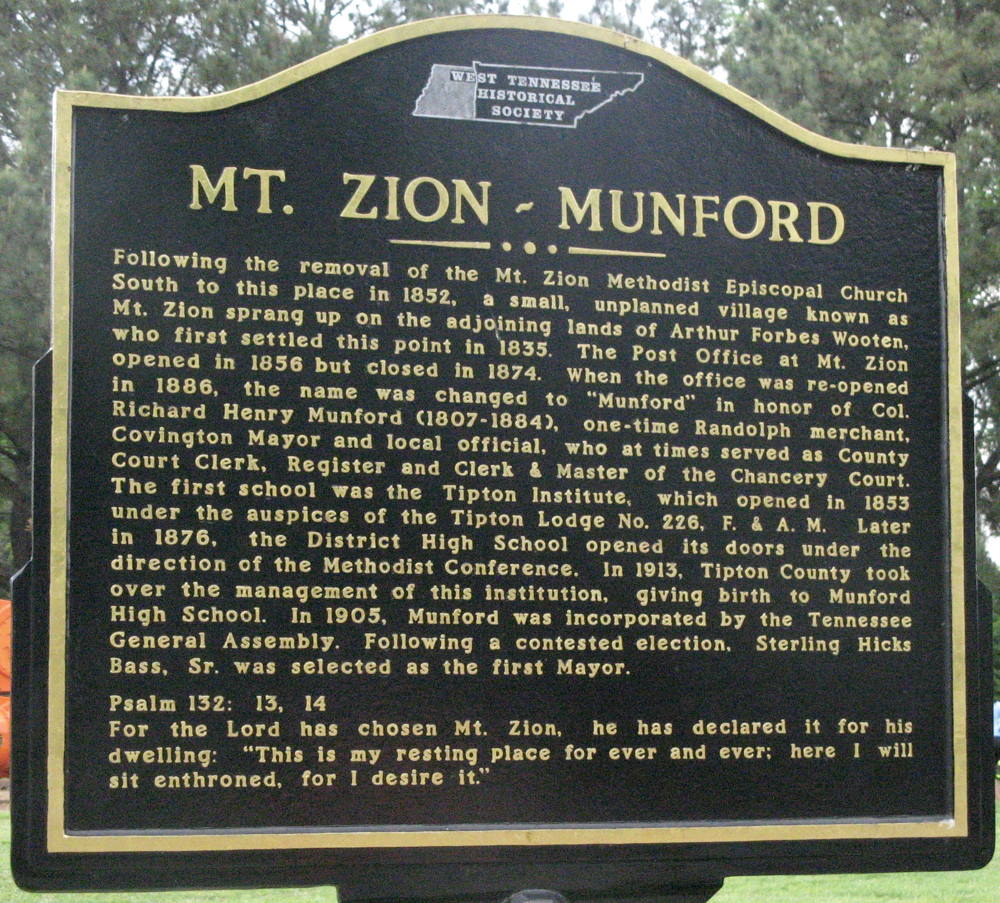
Obion County
Obion County, in the NW corner of Tennessee was created in 1823 from Indian lands and is named for the Obion River, which flows through the southeastern part of the county. The origin of the name is unknown, possibly an Indian word meaning “many forks”. The original county seat, laid out with the help of Davy Crockett was Troy, but was moved to Union City in 1890. It was in Obion County that Davy Crockett claimed to have killed a record 103 bears.
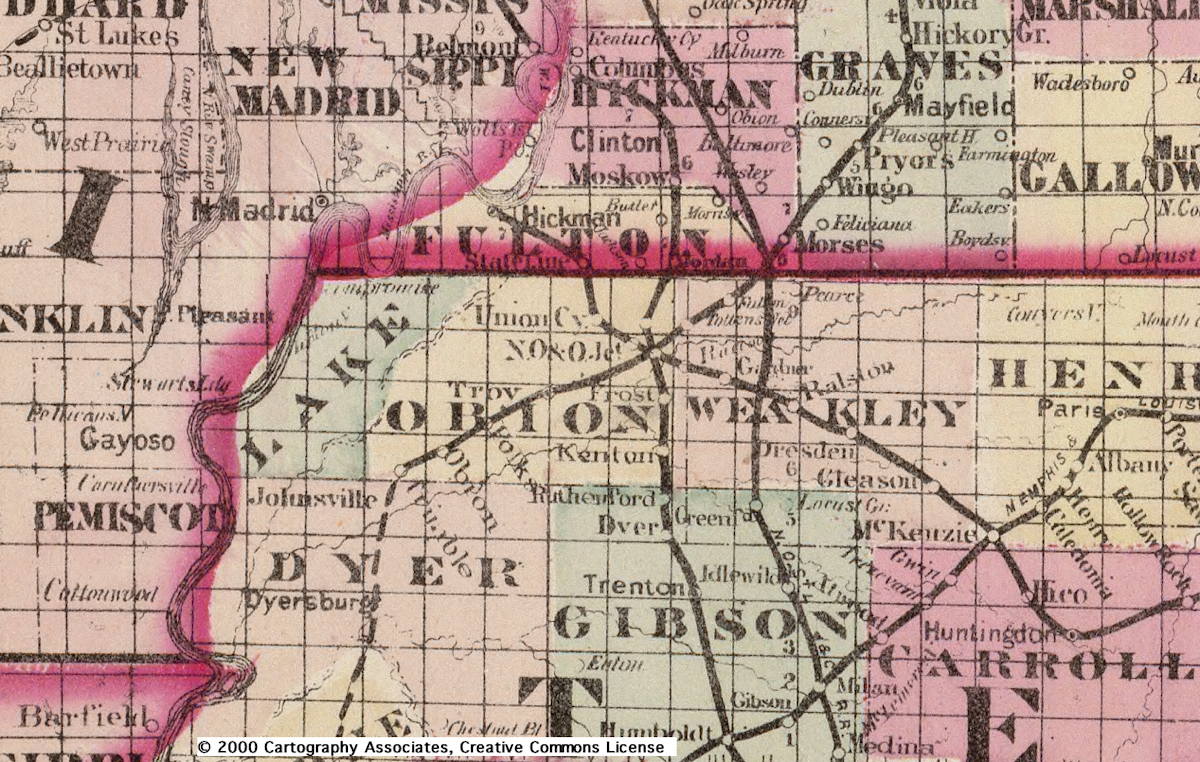
Obion County, TN 1775 *
Early settlers were Scots-Irish from the Carolinas and Virginia, the first known was Elisha Parker, who came to the area in 1819. In December of 1824, a group of 43 settlers led by James Harper and including Samuel and William Hutchinson, left York County, South Carolina in a wagon train headed for West Tennessee. Their original destination was Forked Deer County in West Tennessee (does not exist today), but were advised in Nashville to go to Obion County, instead. After a journey of nine weeks, they arrived in the vicinity of what is today Troy on 17 February 1825 and settled there. Over the next few years, many more settlers left South Carolina for Obion County and by 1830 the population was about 2000. The area continued to grow rapidly and by the beginning of the Civil war, the county population was over 12,000.
As was often the case, the new settlers almost immediately begin to organize church services. Several missionary ministers from South Carolina preached there over the next several years and in 1832 the Troy Associate Reformed Presbyterian Church was organized by the Rev. Eleazar Harris from Chester County, SC. The church prospered, but was not on a sound financial footing. In 1847 Rev. J. P. Weed was installed as the pastor of the Troy congregation in December. His salary was to be $300, and because of the weakness of the church financially, the Salem congregation of Tipton County, of which Rev. John Wilson was pastor, subscribed about $80 per year for three years to help pay the salary. Eventually there would be three ARP churches in Obion County, one at Rives and another at Polk, in addition to the church at Troy. Rev. John L. Boyd, the son of William Baldrige Boyd, was the pastor at Rives from 1917 until 1921.
_________________________
* These images are copyright © 2000 by Cartography Associates. Images may be reproduced or transmitted, but not for commercial use. For commercial use or commercial republication, contact mailto:carto@luna-img.com This work is licensed under a Creative Commons License. By downloading any of these images, you agree to the terms of that license.
Scotland | Ireland | South Carolina | Mississippi | Tennessee | Arkansas | Texas
